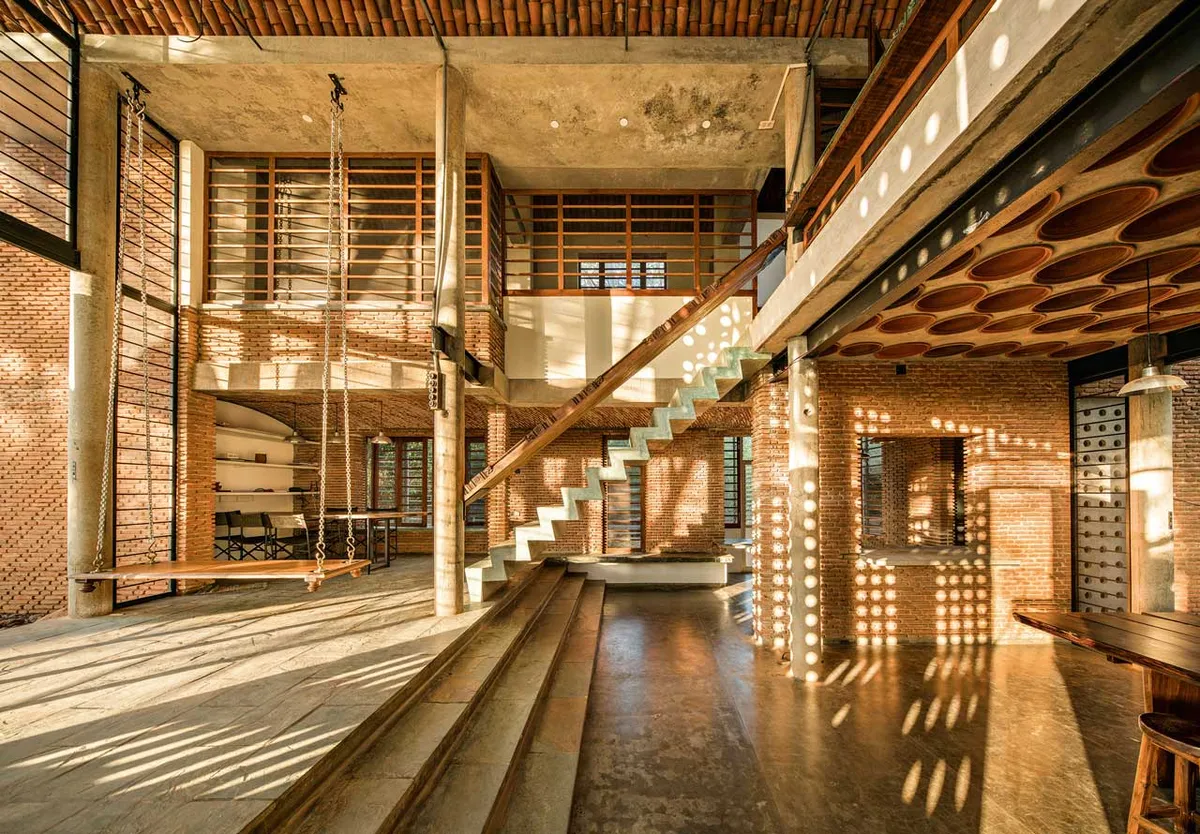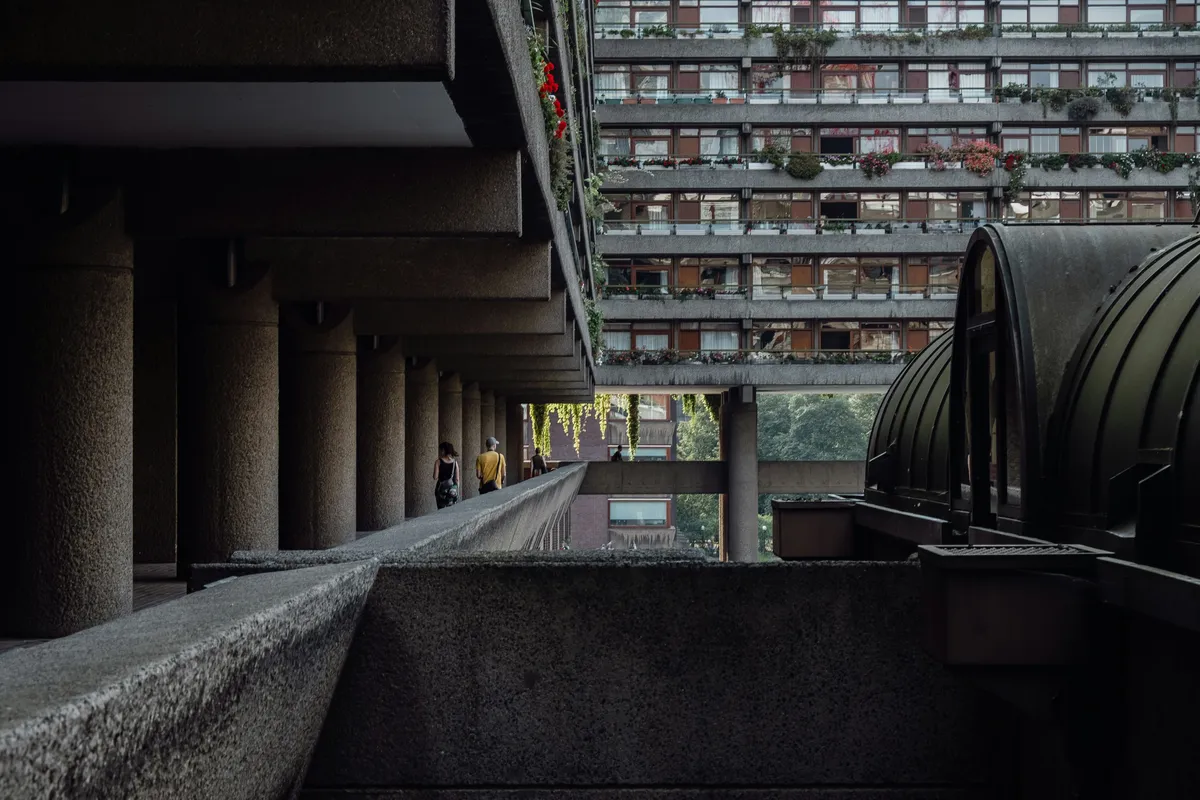How buildings starve the human brain
From London's Barbican to India's experimental villages, radical building projects reveal what humanity desperately needs to survive
The lift shudders to a halt on Shakespeare Tower's seventh floor. Kate Adams steps onto what feels like a concrete destroyer's bridge, forty storeys above London's sprawl. Raw concrete balustrades channel October winds across elevated walkways connecting brutalist towers like urban drawbridges. This is the Barbican estate, a three-dimensional maze that has confounded visitors for fifty years. "I'd wander these walkways for hours, hopelessly lost," Adams recalls, wrestling with oversized keys. "Now I cannot imagine living anywhere else."
Adams represents a generation rediscovering radical design not as aesthetic statement but as neurological necessity. Her flat's porthole windows and soaring spaces create what brain researchers now recognise as optimal mental conditions: geometric complexity that stimulates pattern-recognition systems refined across millennia, precisely modulated daylight that governs circadian rhythms, acoustic properties enabling both intimate conversation and private reflection.
Twenty-five miles east, however, similar post-war towers await demolition after decades of social breakdown. The difference between architectural triumph and catastrophe reveals something profound about human spatial needs that planners have systematically ignored.
When the laboratory exploded
In July 1972, dynamite charges reduced St Louis's Pruitt-Igoe housing complex to smoking rubble. The 33 eleven-storey towers had housed 10,000 residents according to principles borrowed from Le Corbusier's utopian manifestos. Within two decades, crime and vandalism had rendered them uninhabitable. "Modern architecture died in St Louis, Missouri on July 15, 1972, at 3.32 pm," declared critic Charles Jencks.
But architecture hadn't perished—it had demonstrated its power to reshape human behaviour in ways designers never anticipated. Subsequent research reveals that Pruitt-Igoe's breakdown stemmed less from poverty than from spatial arrangements violating basic principles of cognition. Skip-stop lifts forced residents into stairwells where violence flourished. Gallery "streets in the sky" became territorial battlegrounds rather than social spaces. Most destructively, monotonous repetition of identical modules triggered what environmental psychologists term "sensory starvation"—measurable stress when pattern-hungry brains receive insufficient stimulation.
"We evolved processing environments of staggering complexity," explains Dr Colin Ellard, who studies design's neurological impact at the University of Waterloo. "Our brains constantly hunt patterns, evaluate spatial relationships, assess threats and opportunities. Deprive that system of input—surround people with predictable, identical forms—and you create biological stress that manifests as depression, anxiety, even violence."
This insight has revolutionised understanding of why some ambitious projects succeed whilst others catastrophically implode. The determining factor isn't aesthetic preference but biological compatibility with cognitive systems shaped by millions of years of evolution.
The village laboratory

Six thousand miles from London's concrete armadas, architect Anupama Kundoo threads through her Wall House in Auroville, the idealistic community near India's southern coast. Gossamer-thin bricks, barely thicker than roof tiles, rise into soaring walls that fragment harsh sunlight into dancing patterns. Catenary vaults built from custom clay tubes eliminate steel whilst creating natural cooling systems. Terraced roofs with geometric modules unfold like three-dimensional gardens.
"I craved emptiness after childhood chaos," Kundoo explains, gesturing toward pavilion-like spaces that dissolve boundaries between interior and exterior. But emptiness doesn't mean sensory deprivation. Every surface bears human traces: the deeply carved textures of boundary walls, the ship-like detailing of concrete columns, the intricate geometries where four roofing systems meet and separate like musical themes.
Wall House embodies a fundamentally different philosophy from the top-down modernism that spawned Pruitt-Igoe. Rather than imposing universal solutions, Kundoo weaves together abundant local materials and ancient techniques, "transforming them through critical thinking and evolving human ingenuity." The result achieves what environmental psychologist Christopher Alexander calls "living geometry"—complexity that human senses recognise as fundamentally nourishing.
Yet Kundoo confronts a troubling paradox. Despite decades developing low-cost, climate-responsive techniques, her innovations remain isolated experiments rather than scalable solutions. Wall House attracts international pilgrimage but fails to transform India's housing crisis. The knowledge economy of Auroville, she admits, has generated architectural poetry whilst mass housing defaults to soul-crushing standardisation.
The replication catastrophe
The contradiction becomes stark when comparing Wall House's artisanal richness with the standardised developments mushrooming across India's expanding cities. Developers replicate proven formulas—concrete boxes, mirrored glass, air-conditioned isolation—that sever connections to climate, culture, and craft traditions. These "copy-paste" environments provide shelter whilst creating what housing researcher Mohamed Hesham Khalil terms "cognitive prisons"—spaces prioritising "predictability and comfort at the expense of mental stimulation."
The neurological toll of such environments is now measurable. Studies using sensors that monitor stress hormones, skin conductance, and brain activity reveal that people experience anxiety responses when encountering monotonous building facades. Complex, varied surfaces trigger positive reactions; simple, repetitive ones generate biomarkers associated with depression. For rapidly urbanising societies, the mental health implications are catastrophic.
"Architecture can kill just as effectively as an axe," observed 19th-century housing reformer Heinrich Zille. Contemporary neuroscience suggests his metaphor was literal truth. Environments failing to provide appropriate sensory stimulation don't merely bore inhabitants—they inflict measurable psychological damage through mechanisms evolution refined across deep time.
The successful mutation

Which illuminates the Barbican's unlikely triumph. Unlike Pruitt-Igoe's isolated monuments, the complex integrates housing, education, and culture within dense, walkable networks. Unlike copy-paste developments, every corridor reveals unique spatial relationships, material textures, acoustic signatures. Most crucially, elevated walkways create what urban theorist Jane Jacobs called "eyes on the street"—natural surveillance promoting both safety and spontaneous social contact.
"The details seem adopted from a naval destroyer," observes architectural critic Jonathan Glancey, himself a Barbican resident. This maritime toughness masks sophisticated attention to psychological requirements. Complex three-dimensional circulation creates what psychologists term "spatial mystery"—environments inviting exploration and discovery. Integration of water features, gardens, and the tropical conservatory provides access to natural complexity that human cognition demands.
Most tellingly, the Barbican's reputation has completely inverted. Initially dismissed as "concrete brutalism," it now commands premium rents and international study tours. This transformation suggests that successful innovation doesn't merely accommodate human needs but gradually educates users to appreciate previously unfamiliar spatial experiences.
The survival question
The stakes transcend professional debates or aesthetic preferences. The climate crisis demands radical innovation in how billions inhabit the planet, whilst accelerating urbanisation requires housing solutions that accommodate unprecedented population density without destroying psychological resilience. These challenges cannot be met through nostalgic replication or standardised mass production.
Yet modernism's wreckage offers sobering lessons about imposing untested spatial arrangements on vulnerable populations. Housing project failures demonstrate how good intentions combined with biological ignorance can create environments that actively harm inhabitants.
The solution isn't abandoning innovation but conducting it more intelligently. Wall House succeeds through combining formal invention with deep understanding of local conditions and human sensory needs. The Barbican succeeds through providing complexity, community integration, and gradual spatial education rather than shocking rupture with familiar patterns.
Most importantly, successful projects acknowledge that human adaptability has limits. Our cognitive architecture evolved across millennia to process natural complexity, navigate social hierarchies, evaluate environmental threats. Design that ignores these biological realities—whether through monotonous repetition or arbitrary formal experiment—creates measurable stress that erupts as depression, antisocial behaviour, even violence.
Laboratory earth
The COVID-19 pandemic conducted an inadvertent global experiment in spatial psychology, confining billions to domestic environments designed without considering extended occupation. Results were predictable: anxiety, depression, and cognitive decline disproportionately struck those in spaces lacking natural light, outdoor access, or sensory variety. The crisis revealed how profoundly built environments shape psychological resilience and adaptive capacity.
As climate chaos accelerates and urban populations surge, humanity confronts an unprecedented challenge: creating environments supporting both ecological sustainability and mental wellbeing for billions. This cannot be achieved through either nostalgic traditionalism or reckless formal innovation.
Instead, it requires what Kundoo calls "freedom from the known"—willingness to question inherited assumptions whilst respecting empirical understanding of human spatial cognition. It demands architects combining innovative thinking with humility before the evolved neural architecture governing how humans perceive, navigate, and inhabit space.
The Barbican and Wall House offer templates for such intelligent experimentation: projects pushing spatial boundaries whilst remaining deeply attentive to biological realities of human habitation. They suggest that architecture's great laboratory should continue operating—but with greater wisdom about the neurological foundations of spatial experience and the catastrophic costs of failed experiments.
From this perspective, copy-paste housing developments represent not cautious pragmatism but dangerous experimentation with human psychological wellbeing. Their monotonous repetition violates biological principles governing spatial cognition, creating environments that may provide shelter whilst undermining the sensory complexity human flourishing requires.
The choice facing humanity isn't between experimental and conventional architecture but between intelligent innovation informed by biological reality and reckless innovation that ignores it. Our species' survival may depend on distinguishing between these fundamentally different approaches to spatial design.
In architecture's great laboratory, every building is an experiment. The question is whether we're experimenting intelligently or blindly—and whether we're learning from the results.